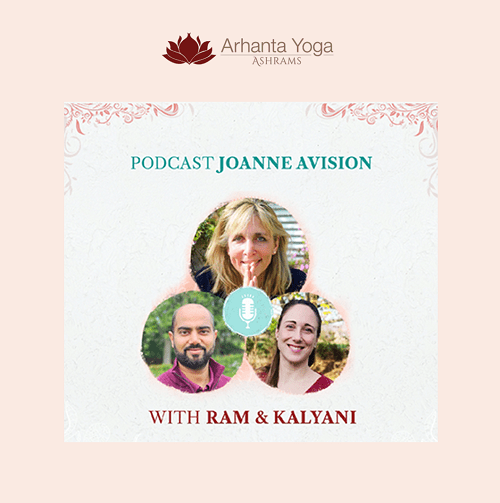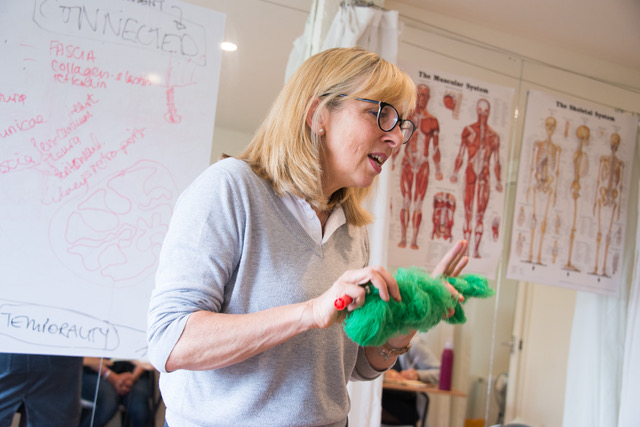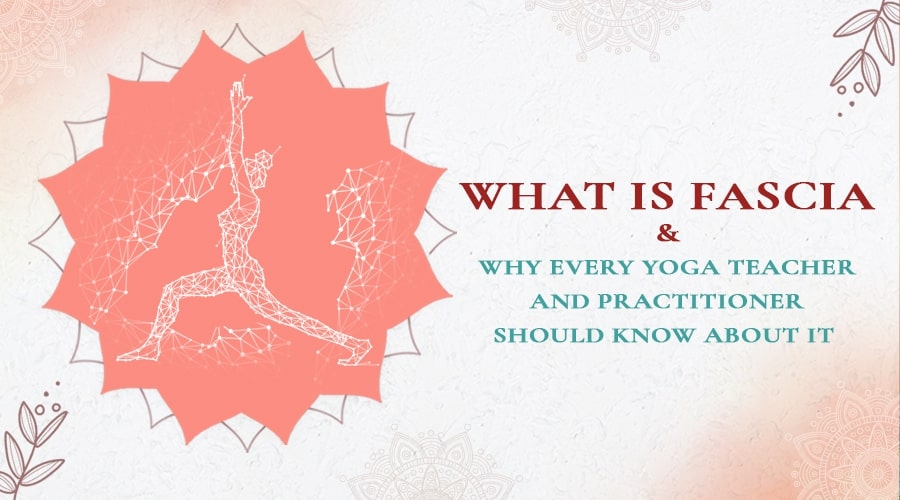Fascia Yoga: Importance for yoga teachers and practitioners
Take a moment to think what you actually remember about the human body from yoga anatomy classes. What do you remember about the human body, in its entirety? After all, the human body is a fascinating and incredible organism that functions as a unit!
Do the terms fascia and fascia release ring a bell? When yoga teachers and physical therapists study the body, it's still a common practice to look at it in such a way that takes us away from the body, as a whole. We are directed to examine the details of how the body can be separated or broken down into its component parts and different systems. We turn to various work based on long-held knowledge in the fields of classical anatomy, physiology, and biomechanics. In recent years, the concept of fascia has become more popular and is addressed but usually as a side topic during yoga anatomy classes.
Even though the concept and principle of fascia and myofascial release have become more recognized in the context of physical therapy and yoga, the principal approach to anatomy largely remains centred around the naming of our parts, understanding our physical systems, and explaining how we move according to those physiological functions.
We learn which parts are where (topographic anatomy; emphasizing the relations between various structures such as muscles and nerves and arteries), to explain the systems in which those parts function (biology and chemistry) and to describe the movement (locomotive) apparatus and how it works.
Muscle–bone–joint anatomy is largely the foundation upon which we base our understanding of the locomotor system. In other words, we learn the ‘bits’ that make the whole and understanding the experiential component of ‘being inside the moving body’ is largely assigned to the separate study of psychology, at least in the Western tradition.
To understand how we do the postures we focus on the musculoskeletal system. We try to comprehend which muscles move which bones via their specific attachments and remember how muscles move; contractions and extensions. By learning how the nervous system works and assigning specific nerves to each muscle, we are supposed to work out the anatomy of posture but, can we really understand our bodies and our movement in this way? This is the new question our new friend fascia calls us to ask.
The traditional foundation of (yoga) anatomy
Once we have learned the basics of muscles and bones, we name the ligaments that attach the bones of the skeleton to each other and the tendons that attach the muscles to those bones. we then find out how, between them, they activate the various types of leverage at the different types of joint. This is a gross simplification of the basic premise upon which the musculoskeletal system, its form and function rest.
In this system, each muscle has:
a name and position,
an origin,
- an insertion (or distal and proximal attachment), and
- an action
The whole suite of muscle-bone-joint anatomy is then proposed to combine so as to motivate a system of levers and pendulums that allows our bodies to move around in gravity. Each nerve is thought to send a signal to the brain and receive one; thus, somehow stimulating those muscles, to undertake the various movements assigned to their position and named function. This is not untrue; however, the notion implies that each muscle moves (or is moved) separately.
In either case, it becomes more complex and difficult to divide topics or work out what overlaps what and which functions belong to which system. We require ever more complicated rules, for more detailed fragments. Gradually, the ability to make sense of the wholeness that arrives in the yoga classroom can become more elusive, for us as anatomy students.
Embodied fascia: A contemporary understanding of yoga anatomy
Anatomy principles and yoga
In yoga books on anatomy, these principles are usually presented via poses (asanas), with a related image showing which muscles are contracted or activated, which are ‘stretched’ by the active contractor, and the point at which they are individually attached in their so-called ‘antagonistic pairs.’ A great deal has been learned, developed, researched, and written about from this particular perspective.
This traditional view, however, excludes a key feature, namely the role of the fascia and the structural role of its architecture. It is in fact the fabric of the connective tissue that joins ALL the parts and systems we have referred to so far and makes them into a whole body.
There is, really, one fascia expressing itself in multiple forms.
What is fascia?
Fascia is the name given to a specific (and variable) kind of connective tissue that is becoming the subject of a rapidly increasing amount of research with regard to its range and capabilities (1).
The fascia is what we might call the stuff in-between, something that in traditional dissection has mostly been removed. In anatomy laboratories, it has been treated more as a kind of inert packaging material that gets scraped away in order to properly present the more important items, such as the muscles, joints, bones, and materials of the ‘musculoskeletal system.’ It was considered to be separate from the nerves, vessels, and other systems of the body. Until very recently, its unity (which of course resonates with yoga as a foundation just by name) could not be appreciated.
Fascia could be described as the fabric of our form, although it is much more than that. It literally joins every single part of the physical inner world together. Fascia is present from the finest level of detail within us, between the cells, to the outermost layer of the skin in which we are wrapped.
In some anatomical representations of the body, it is presented in white against red muscles. What is usually less obvious is that it is invested throughout those muscles and forms the connecting membranes (septae) between them. It is continuous with, rather than separate from, the tendinous attachments, and much more. Muscle tissue arises from within the fascia, not the other way around.

Discover fascia’s amazing role in yoga
Get free access to an exclusive podcast with fascia anatomy expert Joanne Avison
The components of fascia
Fascia includes tendinous sheets (aponeuroses) and chords (tendons), connecting webs (some strong and some gossamer-like), and various types of tissues forming joints, attachments, and continuous connections throughout our bodies. It has been suggested that the entire body is made up of variations on this tissue theme: that bone is a calcified form of the fascia at its thickest, hardest, and most compressed, while cartilage comes next, with high hyaline content, then ligament, then tendon, then myo-fascia containing numerous muscle fibres.
These are all (including bone) types of “soft tissues”. This building material in our bodies (i.e., the fascia) varies in thickness and density, extending even to the softest and most delicate membranes, such as the eardrum.
Whatever the different parts of it are named, the fascia certainly forms what can only be described as an entire matrix that surrounds everything, connects everything, yet paradoxically disconnects everything at the same time. In other words, it distinguishes one part of our body from another since everything is wrapped in it. It also holds together the extracellular matrix, that is, the fluid (or more accurately, the “liquid crystal”) environment in which the cells that make up our organs and parts reside. The fascia contains them and our bodily “colloids and emulsions” in its variety of expressions as the basic tissue of our whole structure, or human architecture.
And, just as importantly, fascia contains the spaces in which the cells reside; it is not limited to the cellular structure. It forms the containers the cells are contained in.
The unity of fascia & the unity of yoga
What has been overlooked when fascia is removed in the traditional way is its universal connectivity and, therefore, the unifying principle that has resonated with the foundations of yoga, from philosophy to physiology.
Fascia does not replace musculoskeletal anatomy but includes, enhances, and evolves it. It does the same to all the classified systems of the body, most particularly the nervous system.
From a yoga perspective, studying what we could call “fascial anatomy” makes complete sense. This study brings the art of yoga into a powerful contemporary focus. It shines relevance to health and wellbeing on every level. As a yoga teacher or yoga practitioner, you should know the following about fascia.
How yoga works on the fascia
To include fascia in the study of yoga anatomy makes complete sense. It ties into the art and science of yoga in all its contemporary forms.

The fascia includes both the physical and the mental aspects of yoga study, from the postures to the ability to manage various bodily systems (i.e., respiration and more refined practices of self-management) and meditation.
The significance of the fascia to studies of the human body has been quite astonishingly underestimated given that:
- It is alive and anything but passive
- It is a sensory organ that is re-writing the classical understanding of the nervous system
- It is literally everywhere within and
- it is continuous throughout our form, on every scale, joining and relating everything to everything else.
This combination of characteristics amounts to the recognition of the fascia as the master of our sense of where we are in space.
This sense is additional to the commonly held belief that we are five-sensory creatures. It is developing as the basis of our sixth, very important (probably primary) sense: the one that tells us where we are relative to our environment and ourselves at any point in time.
This is particularly relevant to teaching yoga as it relates to the profound study of balance and motion, coordination, and stillness – all of which are an essential part of our work on the mat, and off the mat, over time. This sense is known as proprioception – and the fascia becomes our tissue of temporality. That which registers and signals what we do repeatedly over time – and how we anticipate on the mat.
Proprioception: Understanding the primary sense of fascia and movement
Proprioception is the sense that tells us where we are in space at any given moment.
“Proprio” comes from the Latin propius, meaning “one’s own”, and “ception” comes from perception. So, the translation of proprioception is “one’s own, or self, perception”.
Proprioception is at work when we write an email, pluck strings to play a musical instrument, or walk or run or stand or sit or do anything. Fascia is referred to as our organ of organization and its proprioceptive qualities are subtle and extensive. In yoga, it is essentially the sensing of every part of us, in any given pose, relative to every other part and the mat, or ground beneath us.
Current research challenges our traditional notions of anatomy, physiology, and biomechanics and shakes the foundations of many classic principles of the systems they include.
At the same time, it offers a new context that unifies not only the different parts of the body but also the being that resides within it. It could also be said to be uniting many different aspects of science as well as parts of the body.
This is an exciting time to be a yoga teacher since union is such a founding, ancient aspect of yogic wisdom and so fundamental to the contemporary art of yoga in all its variety.
Understanding the fascial matrix takes us from the “flatland” of anatomical parts to the global understanding that the living body is a volume in space, that holds itself up and moves in all directions regardless of position relative to the ground.
This constitutes a paradigm shift in our understanding of anatomy. It makes a new sense of pain, scar tissue, injuries, posture, stretching, strengthening, and many aspects of how the entire human body self-assembles, self-organizes and remains self-motivated.
Fascia mastery for yoga teachers – Online course
Fascia mastery for yoga teachers considers how the anatomy of “bits”, now upgrading to include “bands” (such as anatomy trains and kinematic chains) can in fact be brought to a recognition of whole bodies: much as yoga appreciates in all its aspects: scientific, philosophical, creative and physical. In this course, we will consider the eight principles of fascia mastery for yoga teachers, and look at:
- What is fascia?
- The new science of body architecture
- Elastic breath and biotensegrity
- The heart-centered embryo
- Awakening the fascial spine
- Fine-tuning the spinal instrument
- The fascial limbs
- The elastic body – from speed to stillness
Fascia is our connective tissue literally and symbolically; it bridges the gap between classical and contemporary anatomy and makes sense of how we move.
This carefully designed course guides you through bridging that gap. Through practical presentations, movement sessions, theory, and guided meditation you will be empowered to understand animated living architecture, as a human being. This course will transform your mastery of anatomy-in-practice to the mat, whatever level you begin from. It is a clear step-by-step progressive course, written and presented in plain English.
Resources
- The number of papers on fascia indexed in Ovid, the MEDLINE, and Scopus databases has grown from 200 per year in the 1970’s and 1980’s to almost 1000 in 2010 (Robert Schleip, Thomas W. Findley, Leon Chaitow and Peter A. Huijing, Fascia; The tensional Network of the Human Body, Churchill Livingston/Elsevier, Edinburgh 2012)
- For an illustrated overview see Ch. 1, “The World According to Fascia”, in Thomas W. Myers, Anatomy Trains: Myofascial Meridians for Manual and Movement Therapists, 3rd Edition, Churchill Livingstone, Edinburgh, 2009

Discover fascia’s amazing role in yoga
Get free access to an exclusive podcast with fascia anatomy expert Joanne Avison

